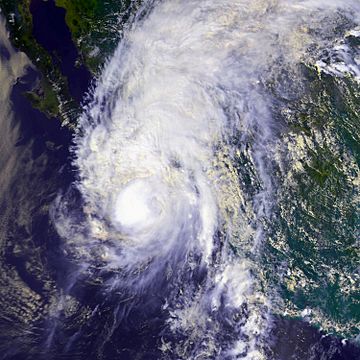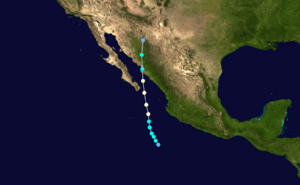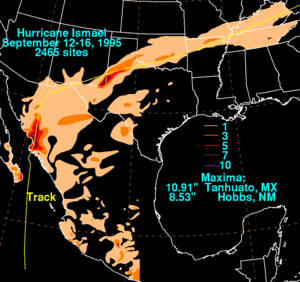Hurricane Ismael facts for kids
| Category 1 hurricane (SSHWS/NWS) | |

Hurricane Ismael off the coast of Baja California
|
|
| Formed | September 12, 1995 |
|---|---|
| Dissipated | September 16, 1995 |
| Highest winds | 1-minute sustained: 80 mph (130 km/h) |
| Lowest pressure | 983 mbar (hPa); 29.03 inHg |
| Fatalities | 116 direct |
| Damage | $26 million (1995 USD) |
| Areas affected | Northern Mexico |
| Part of the 1995 Pacific hurricane season | |
Hurricane Ismael was a powerful storm that formed during the 1995 Pacific hurricane season. It started on September 12, 1995. By September 14, it had grown into a hurricane off the coast of Mexico.
The hurricane moved north and hit the land in Sinaloa, Mexico. After hitting land, Ismael quickly lost its strength. It completely disappeared on September 16 over northwestern Mexico.
Out in the ocean, Ismael created huge waves, some as tall as 30 feet (9 meters). The storm destroyed 52 ships and sadly, 57 fishermen lost their lives. On land, Hurricane Ismael caused 59 deaths in Mexico. It also ruined thousands of homes, leaving about 30,000 people without a place to live. The storm's rain even reached parts of the United States, causing heavy rainfall in New Mexico. Ismael was the deadliest hurricane of the 1995 season.
Contents
How the Storm Developed
The storm that became Hurricane Ismael began near the southern coast of Guatemala on September 9. It slowly moved towards the west-northwest. A few days later, a low-pressure area formed off the coast of Mexico.
On September 12, this area grew into Tropical Depression Ten. At this time, it was about 350 miles (560 km) south-southwest of Manzanillo, Colima. The depression moved northwest and became a tropical storm early on September 13.
A nearby weather system over the Baja California peninsula caused Ismael to slowly turn north. Tropical Storm Ismael kept getting stronger as it moved in this direction. On September 14, it officially became a hurricane.
The center of the storm, called an eye, began to form. Just six hours after becoming a hurricane, Ismael reached its strongest point. The storm then sped up as it moved northwest. On September 15, it passed just east of Cabo San Lucas.
Later that day, Hurricane Ismael made landfall in the state of Sinaloa. Once over land, Ismael quickly lost its power. It completely died out on September 16. The leftover rain from the storm continued moving north, reaching parts of the United States.
Getting Ready for the Storm
At first, weather forecasters thought Hurricane Ismael would stay over the ocean. But when they realized it would hit land, the Mexican government issued a tropical storm warning. This warning covered the coast from Manzanillo, Colima, to Cabo Corrientes.
The warning was later extended to Los Mochis. Another warning was given for part of the east coast of Baja California Sur. Forecasters then issued a hurricane warning from Mazatlán to Los Mochis. Before the storm arrived, 1,572 people moved to emergency shelters to stay safe.
What Happened During the Storm
Hurricane Ismael created waves up to 30 feet (9 meters) high in the Gulf of California. Many fishermen were not ready for such a strong hurricane. Because of this, 52 fishing boats were destroyed, and 20 of them sank. About 57 fishermen died off the coast, with some bodies washing ashore. Luckily, 150 other fishermen survived by waiting on islands or sandbars. Navy rescue teams searched for days to find victims and survivors.
The storm brought a lot of rain, with some areas in Sinaloa getting as much as 7.76 inches (197 mm). This heavy rain caused flooding in four different areas. In one place, the hurricane destroyed 373 homes and damaged 4,790 others. The storm also cut off drinking water to 177 houses and caused many power outages.
The damage was very bad where the hurricane first hit land. In Los Mochis, Ismael's strong winds knocked down houses and telephone poles. A total of 59 people were killed in Sinaloa.
Ismael also caused heavy rainfall farther north. Very bad flooding was reported in Huatabampo. Across Sonora, the winds destroyed 4,728 homes and ripped the roofs off 6,827 others. The hurricane also damaged 107 schools. About 100 miles (165 km) of roads were damaged. Around 83 square miles (215 km²) of farm fields were also ruined.
Rain from the remains of Ismael reached southwestern Arizona and southern New Mexico in the United States. The storm also caused heavy rainfall near the border between New Mexico and Texas. This rain led to flooding on roads and in buildings. Several roads were damaged and had to be closed. In Lubbock, Texas, the rainfall caused flash flooding, which forced many roads to shut down. The moisture from the storm even traveled as far east as the Mid-Atlantic States.
After the Storm Passed
Because Hurricane Ismael caused so much damage, its name was officially "retired." This means the name "Ismael" will never be used again for a Pacific hurricane. The name was replaced with "Israel," which was used for a storm in the 2001 Pacific hurricane season.
After Hurricane Ismael, officials gave out 4,800 sheets, 500 cushions, and 1,500 blankets to people affected by the storm. Divers helped to find sunken ships and recover bodies. Workers quickly repaired the communication network. Other workers provided help to people in Sonora.
Related pages
Images for kids
-
Hurricane Ismael making landfall
See also
 In Spanish: Huracán Ismael para niños
In Spanish: Huracán Ismael para niños




